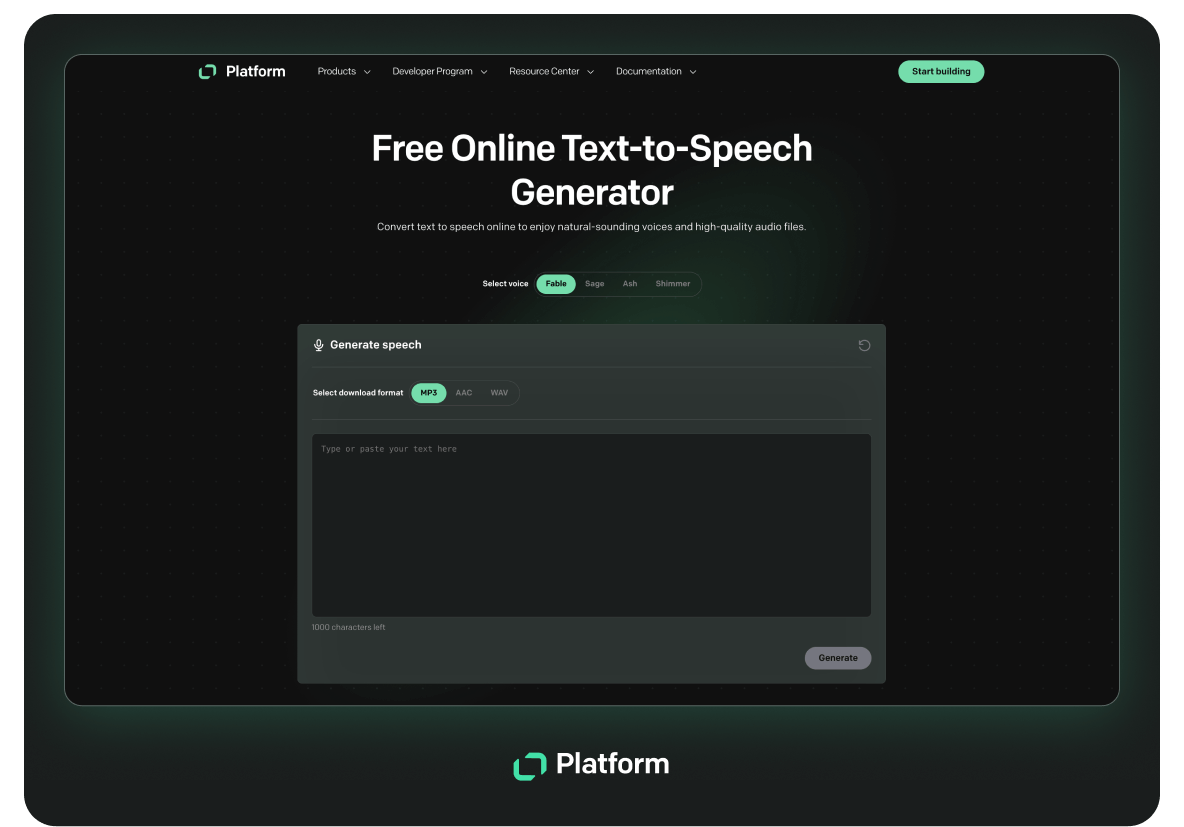What you’ll learn:
- What text-to-speech (TTS) technology is and how it works
- The AI techniques behind synthetic voices, including natural language processing (NLP) and speech synthesis
- Real-world uses of TTS and where the tech is headed next
tl;dr
Text-to-speech turns written text into spoken audio. It’s used in everything from voice assistants to audiobooks — and thanks to AI, today’s synthetic voices actually sound human.
What is text-to-speech technology?
Text-to-speech is powered by natural language processing (to understand the text) and voice synthesis (to produce audio). TTS is widely used in accessibility tools, digital assistants, and content creation. Advanced AI models now enable it to sound more realistic, adapt to context, switch languages, and even express emotion.
Key findings
How does text-to-speech work under the hood?
TTS starts with natural language processing, normalizing text, analyzing grammar, and determining how each word should sound. Then, a voice model — either built from recordings (concatenative synthesis) or AI (neural TTS) — generates audio.
Why are neural models like WaveNet a game-changer?
Neural TTS uses deep learning to generate highly realistic voices. Models like WaveNet and Tacotron have cut the quality gap between real and synthetic voices by more than 50%.
Where is TTS being used today?
TTS powers screen readers, voice bots, game narration, AI tutors, and video voiceovers. Businesses use it to improve accessibility, automate customer service, and create multilingual content faster.
Have you ever wondered how your favorite AI assistant talks to you? Or how can audiobooks and accessibility tools be read aloud with such natural-sounding voices? It’s all thanks to text-to-speech technology. This type of tech turns written text into spoken words, making digital content more accessible and engaging.
If you’ve ever wondered about the technology behind synthetic voices, you’ve come to the right place. This article will take you behind the scenes to understand how technology can turn text into speech that sounds human.
Simply put, text-to-speech (TTS) is a technology that converts written words into spoken language. It’s used in everything from voice assistants and customer service chatbots to screen readers and language-learning apps. The global text-to-speech market was valued at around $3.45 billion in 2024.
The core technologies behind text-to-speech
Text-to-speech systems rely on multiple layers of complex technologies to convert written text into human-like speech. Let’s look at the key components that make this possible.
Text-to-speech technology analyzes text, determines pronunciation, intonation, and speaking rate, and generates audio that sounds like a human voice. The goal is to make interactions with technology more natural and intuitive.
One of the key challenges in text-to-speech technology is maintaining human intonation, which is crucial for natural-sounding speech.
Natural language processing (NLP)
Every text-to-speech system will use natural language processing, which correctly interprets and converts text into spoken words. NLP handles several tasks needed for text-to-speech technology to function:
- Text normalization: Expanding abbreviations, numbers, and symbols into whole words. For example, it helps to convert “$5” into “five dollars.”
- Linguistic analysis: Understanding syntax, grammar, and structure to generate fluid speech.
- Prosody modeling: Assigning appropriate pitch, stress, and rhythm to words for natural-sounding speech.
NLP is crucial for accurately interpreting written content and converting it into natural-sounding speech. According to a study by Stanford University, modern NLP models trained with deep learning algorithms have improved speech accuracy by over 85% in the last decade.
Speech synthesis models
Once the text is processed, it moves to the speech synthesis stage, where a voice generator creates the actual voice output. Two major methods dominate this space.
Concatenative synthesis
This method stitches together pre-recorded voice samples from a human speaker to form sentences. While it produces high-quality speech, it lacks flexibility and requires a large dataset of voice recordings.
Neural text-to-speech (deep learning-based synthesis)
Modern text-to-speech systems leverage deep learning models like WaveNet and Tacotron to generate synthetic speech. These models use AI to predict speech waveforms, making the output more natural and expressive. Neural text-to-speech adapts better to different contexts, accents, and emotions, providing a more dynamic user experience.
A Google DeepMind study found that WaveNet reduced the gap between human and synthetic speech quality by 50% compared to previous methods.
Text analysis and context understanding
Advanced text-to-speech solutions go beyond reading text and attempting to understand contextual meaning. AI models use deep learning to predict how words should be pronounced based on their placement in a sentence. This is important for homographs, which are words spelled the same but with different meanings. The English language has many of these, so this technology is vital for text-to-speech.
- Semantic understanding: AI interprets sentence structures to adjust pronunciation for words with multiple meanings.
- Contextual word emphasis: Models analyze word relationships within sentences to apply appropriate stress and intonation.
- Punctuation awareness: Systems recognize punctuation to introduce appropriate pauses for a more natural flow.
A report by MIT’s CSAIL department showed that context-aware TTS models improve pronunciation accuracy by up to 40%, which is why they are necessary for real-world applications.
Text Platform: A powerful tool for developers
The Text Platform is a place for developers who want to expand their reach and sell their products on external marketplaces. It offers multiple APIs and SDKs that allow developers to enhance their applications by integrating chat messaging, reports, or configuration functionalities. These tools make it easy for developers to extend Text's existing products or create standalone solutions that interact with various text operations.
Expanding developer capabilities
- Marketplace access: Developers can publish monetized apps on the Text Marketplace, offering passive income opportunities and instant exposure to an established customer base.
- Integration with leading communication products: Developers can build apps that extend industry-leading tools like LiveChat and HelpDesk, increasing business functionality.
- Developer Console & integrations: The intuitive Developer Console supports efficient app development and integrates with tools like GitHub, Vercel, Netlify, PlanetScale, and Neon.
Key features of the Text Platform’s text-to-speech app
For developers looking to integrate text-to-speech into their applications, The Text Platform provides a flexible solution.
- Natural-sounding voices: Offers a variety of AI-generated voices designed to mimic human speech patterns for a high-quality listening experience.
- Multiple language support: Enables developers to convert text into speech in different languages.
- Multiple output formats: Generates audio files in widely used formats like MP3, AAC, and WAV, making it compatible with various platforms and applications.

Technical aspects of the Text Platform
- Secure authentication: API calls are secured with OAuth 2.0 authentication for safe and authorized access.
- WebSocket capabilities: Developers can utilize WebSockets for interactions, making it ideal for interactive applications.
- Free text reader: The platform offers a text-to-speech reader that is accessible without complex logins and supports downloading audio files.
Real-world applications of text-to-speech
Text-to-speech technology is widely used across various industries, improving accessibility and automation. Some key applications:
- Customer support: AI-driven virtual assistants and interactive voice response (IVR) systems improve customer service by responding with neutral-sounding speech.
- E-learning & accessibility: Screen readers and educational tools enable people with visual impairments or reading difficulties to engage with digital content.
- Gaming & entertainment: Voiceovers for video games, storytelling apps, and AI-generated narration improve immersion.
- Content creation: Automated voiceovers allow creators to add narration to videos (for example, from PDF files), podcasts, and marketing materials.
- AI text applications: AI text technology enhances efficiency and quality in podcasting, conversational interfaces, and video production.
AI ethics and security in text-to-speech
The increasing realism of text-to-speech voices brings up ethical and security challenges. Some key concerns include:
- Deepfake misuse: AI-generated voices can be used for fraudulent activities, making it important to implement detection and authentication technologies.
- Privacy risks: Storing and processing voice data securely is critical for maintaining user privacy.
- Regulatory considerations: Governments and organizations are working to introduce policies governing synthetic voice applications to prevent misuse.
To counter these issues, companies are developing AI-based voice watermarking techniques and secure authentication systems to protect against unauthorized voice replication.
What’s next for text-to-speech?
With AI advancements pushing the boundaries of realism and accessibility, here are some trends shaping the future of text-to-speech:
Emotionally expressive speech
Future advancements in voice generator technology will enable even more realistic and expressive narrations. AI-driven text-to-speech models are improving their ability to convey emotions like happiness, sadness, and excitement, making interactions more engaging.
Real-time voice cloning
Developers are exploring voice cloning techniques that can replicate a speaker’s voice with minimal data, opening new possibilities for personalization.
Multilingual and code-switching capabilities
Advanced text-to-speech engines can handle multiple languages within the same conversation, benefiting international businesses and multilingual users.
Closing thoughts
Text-to-speech technology is revolutionizing how users interact with digital platforms, providing accessibility and efficiency across industries. With AI-powered advancements, text-to-speech is becoming more realistic and customizable than ever.
Whether you’re building an AI assistant, an educational tool, or a voice-enabled chatbot, utilizing the latest text-to-speech technologies will enhance user engagement and expand accessibility.


